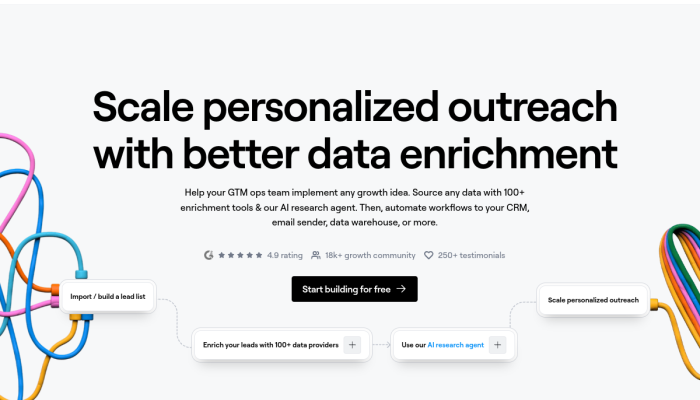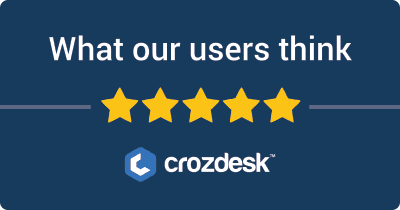
Introduction to Clay and Clearbit in B2B Database Solutions
Clay and Clearbit are two prominent tools in the realm of B2B databases, each serving distinct purposes while offering valuable resources for businesses looking to enhance their marketing and sales outreach.
Main Purposes:
- Clay primarily focuses on helping users enrich their customer relationship management (CRM) data by automating the process of data collection and organization, making it easier to connect with potential leads.
- Clearbit, on the other hand, specializes in providing deep insights into companies and their decision-makers, enabling businesses to craft targeted marketing campaigns and improve lead qualification.
Common User Considerations: Both platforms are sought after for their ability to improve lead generation and streamline sales processes. Users typically consider these tools for their efficiency in data enrichment, ease of integration with existing software, and capabilities for improving customer targeting.
Comparison Aspects:
- Features: Assessment of data enrichment, integrations, and user interface.
- Pricing: Analysis of subscription models and cost-effectiveness relative to the value provided.
- Ease of Use: Evaluation of user experience, onboarding processes, and customer support.
This overview sets the stage for a detailed comparison of Clay and Clearbit, helping users make informed decisions based on their specific business needs.
Clay VS Clearbit: Which tool is the most popular?
| Tool | Number of Reviews | Average Rating | Positive Reviews | Neutral Reviews | Negative Reviews |
|---|---|---|---|---|---|
| Clearbit | 11 | 4.18 | 10 | 0 | 1 |
| Clay | 12 | 1.92 | 3 | 0 | 9 |
Clearbit is the most popular tool based on the average user rating of 4.18 and a high number of positive reviews (10 out of 11). In contrast, Clay is the least popular, with an average rating of 1.92 and a significantly higher number of negative reviews (9 out of 12).


Clay and Clearbit: Quick Comparison Overview
| Feature/Aspect | Ahrefs | SEMrush |
|---|---|---|
| Primary Features | – Site Explorer – Keyword Explorer – Backlink Checker – Content Explorer – Rank Tracker |
– Keyword Research – Site Audit – Position Tracking – Content Analyzer – Marketing Insights |
| Target Audience | – SEO professionals – Digital marketers – Agencies focusing on content marketing and backlink analysis |
– Digital marketers – SEO experts – Content marketers – Social media marketers and PPC specialists |
| Main Advantages | – Robust backlink analysis – Comprehensive keyword data – Intuitive user interface – Constantly updated index |
– All-in-one digital marketing tool – Extensive competitor analysis – Wide array of tools for SEO and PPC – Integrated social media management |
| Core Value Proposition | Focused on providing in-depth SEO insights, particularly strengths in backlink profiles and organic keyword rankings. Ideal for users prioritizing content strategy and link-building efforts. | Offers a holistic view of digital marketing, making it easier to manage all aspects of online presence through an extensive range of tools for SEO, PPC, and social media marketing. |
| Ideal Use Cases | – Conducting comprehensive link audits – Developing effective content strategies – Tracking backlinks and organic rankings – Keyword planning for SEO campaigns |
– Managing and optimizing PPC campaigns – Conducting competitive analysis for market positioning – Comprehensive content analytics and SEO tracking – Social media metrics and management |
Most liked vs most disliked features of Clay and Clearbit
| Product | Most Liked Features | Most Disliked Features |
|---|---|---|
| Clay | – Delivery tracking information is appreciated. | – Trustworthiness questioned due to non-delivery issues and lack of responses. |
| – Effective communication and quick responses to inquiries are highlighted. | – Lengthy waiting periods for orders, sometimes taking weeks or months, cause frustration. | |
| – Customer satisfaction with the quality of products upon fulfillment. | ||
| Clearbit | – Accurate data about companies and contacts, especially in Salesforce, is praised. | – Concerns about the accuracy of specific data points, like phone numbers and certain company profiles. |
| – Intuitive user interface and seamless Salesforce integration enhance workflows. | – High pricing makes it less accessible for smaller companies. | |
| – Features for transforming website visitors into leads and targeting customers improve marketing strategies. | – Initial configurations can be tricky, potentially leading to unintended updates. | |
| – Saves time for SDRs by providing readily available data and reducing research needs. | – Product may be more suitable for larger organizations, potentially neglecting smaller firms’ needs. | |
| – Excellent customer support assists with implementation and troubleshooting. | – Frustration over the lack of notifications about feature upgrades or required refreshes, leading to missed benefits. |
Key Features of Clay vs Clearbit
Sure! Here’s a comparison of the key features of Clay and Clearbit, particularly focused on their B2B database functionalities, along with the benefits each feature provides to users and any unique aspects each brand offers.
Clay
Key Features:
-
Data Enrichment:
- Benefit: Clay allows users to enrich their existing data with verified information from various sources. This ensures that the records are up-to-date and accurate.
- Unique Aspect: Clay integrates with multiple other apps and databases, providing a holistic view by consolidating data from different platforms into one interface.
-
Custom Lists:
- Benefit: Users can create custom lists based on specific criteria, which helps in targeting the right audience for sales and marketing efforts.
- Unique Aspect: The powerful filtering options allow users to craft highly targeted lists based on nuanced characteristics.
-
Integration with CRMs:
- Benefit: Clay seamlessly connects with popular CRMs, making it easy for teams to manage their leads and customer relationships without switching platforms.
- Unique Aspect: The integrations are designed to enhance existing workflows, minimizing disruptions while augmenting the data with insightful information.
-
Automated Workflows:
- Benefit: Clay includes features that enable users to automate repetitive tasks, saving time and resources that can be better spent on strategic decisions.
- Unique Aspect: It allows teams to set up highly customized workflows that cater to their specific operational needs rather than relying on one-size-fits-all solutions.
-
Collaboration Tools:
- Benefit: Built-in collaboration features allow team members to communicate, share insights, and maintain transparency on projects.
- Unique Aspect: Clay’s intuitive design makes it easy for various team members to engage with the platform, fostering a more cohesive approach to data management.
Clearbit
Key Features:
-
Real-time Data Enrichment:
- Benefit: Clearbit provides real-time enrichment of leads, offering users immediate access to updated company and contact information.
- Unique Aspect: Their enrichment is not only fast but also integrates deeply with introductory workflows for immediate use in outreach or lead scoring.
-
Lead Scoring:
- Benefit: This feature allows users to prioritize leads based on their likelihood to convert, ensuring sales teams focus on the most promising opportunities.
- Unique Aspect: Clearbit uses machine learning models to improve its lead scoring over time, adapting to user behavior and responses.
-
Intent Data:
- Benefit: By capturing intent signals, Clearbit helps users identify prospects who are actively researching or contemplating purchases, significantly improving sales outreach effectiveness.
- Unique Aspect: Clearbit combines intent data with company insights, providing users with rich contextual understanding to tailor their outreach strategies.
-
APIs and Webhooks:
- Benefit: Clearbit offers extensive API capabilities, allowing users to integrate their services with various applications and create customized functionalities.
- Unique Aspect: The flexibility of APIs allows businesses to automate and synchronize their data across multiple platforms, optimizing their tech stack.
-
Integrations:
- Benefit: Clearbit integrates seamlessly with major CRM and marketing automation platforms, facilitating a smooth workflow across tools.
- Unique Aspect: Beyond typical integrations, Clearbit focuses on helping organizations enhance their existing tools rather than just adding on another software layer.
Conclusion
Clay focuses on user-friendly data management, customization, and automation, making it perfect for teams needing a collaborative space to manage enriched data effectively. Clearbit, on the other hand, excels in real-time data enrichment, predictive lead scoring, and actionable insights from intent data, catering to teams looking to enhance their outreach with intelligence.
Choosing between Clay and Clearbit will depend on the specific needs of the organization, whether they require more customization and interactivity or advanced enrichment and scoring capabilities.
Clay vs Clearbit Pricing Comparison
Pricing Comparison: Clay vs. Clearbit
| Feature/Criteria | Clay | Clearbit |
|---|---|---|
| Free Trial | Yes – 14-day trial | Yes – 14-day trial |
| Monthly Subscription | – Starter: $60 | – Basic: $99 |
| – Growth: $300 | – Pro: $599 | |
| – Enterprise: Custom pricing | – Enterprise: Custom pricing | |
| Annual Subscription | – Starter: $600 (save 15%) | – Basic: $1,188 (save 20%) |
| – Growth: $3,000 (save 16%) | – Pro: $5,988 (save 16%) | |
| – Enterprise: Custom pricing | – Enterprise: Custom pricing | |
| Starter Tier | – Up to 1,000 profiles | – Basic: Up to 1,000 profiles |
| – Limited integrations | – Enrichment API | |
| – Basic support | – Email Verification | |
| Growth Tier | – Up to 5,000 profiles | – Pro: Up to 10,000 profiles |
| – Advanced integrations | – Advanced API access | |
| – Enhanced support | – Customizable workflows | |
| Enterprise Tier | – Custom profiles | – Custom profiles |
| – Premium support | – Dedicated account manager | |
| – Custom integrations | – Tailored solutions | |
| Additional Features | – Collaborative features | – Market Insights |
| – Team management | – Enhanced Customer Data | |
| – API access | – Real-time data updates |
Summary of Key Differences
- Target Audience: Clay’s offerings are more tailored towards smaller teams and startups with more affordable tiers, while Clearbit focuses on larger organizations and provides comprehensive data enrichment offerings.
- Profile Limits: Clay’s Starter tier allows up to 1,000 profiles and provides growth at the Growth tier. Clearbit’s tiers have gradually increasing limits, targeting broader and larger datasets.
- Discounts: Both brands offer different discounts for annual payments but vary in the percentage offered and the structure of their tier pricing.
- Support and Features: Clay emphasizes collaborative and team features, whereas Clearbit provides deeper market insights and advanced customization for established companies.
Support Options Comparison: Clay vs Clearbit
| Support Option | Clay | Clearbit |
|---|---|---|
| Live Chat | Available during business hours, easy access for quick questions. | Available through Help Center, prompt responses to inquiries. |
| Phone Support | No phone support offered. | No phone support offered. |
| Documentation | Comprehensive user guides and FAQs on various features and use cases. | Extensive documentation, including API references and use cases. |
| Webinars/Tutorials | Regular webinars and tutorial videos available for user onboarding and feature deep-dives. | Offers tutorials and case studies, along with occasional webinars for advanced features. |
Unique Features of Clay Vs Clearbit
| Feature | Clay | Clearbit | Added Value and Deciding Factors |
|---|---|---|---|
| Data Enrichment | Combines data from various sources to create rich profiles of individuals and companies. | Offers real-time data enrichment focused primarily on company and contact analytics. | Clay’s holistic approach provides a complete view of relationships, making it easier to understand connections and influence within networks. |
| Custom Workflows | Allows users to build personalized workflows tailored to specific needs or processes. | Provides predefined workflows without significant customization options. | Clay’s customization can enhance efficiency and adaptability in managing leads based on unique business models. |
| Integration Capabilities | Integrates seamlessly with a wide range of applications, allowing users to tailor their tech stack optimally. | Limited integrations, primarily focused on its core services. | Clay’s extensive integration minimizes disruption and enhances productivity by connecting users’ existing tools. |
| Relationship Mapping | Visualizes complex relationships between individuals and companies, showcasing interactions and connections. | Primarily focuses on static data points without visual relationship mapping. | This feature empowers users to leverage insights regarding influence and communication paths for more strategic networking. |
| User-Driven Insights | Provides actionable insights driven by user input and custom criteria rather than only relying on standard algorithms. | Standard insights based on data aggregation and analytics. | Clay’s user-driven insights allow for more relevant and contextualized information that may lead to improved decision-making and engagement. |
| Collaboration Tools | Includes features that facilitate team collaboration on projects and insights sharing. | Limited collaboration features, mostly data management focused. | This promotes efficiency in team operations and enhances collective strategy development, leading to better overall performance. |
| Flexible Pricing Models | Offers flexible, usage-based pricing that scales with business size and needs. | More rigid, tier-based pricing structures. | Clay’s pricing adaptability can accommodate various business sizes, making it a more viable option for startups and smaller enterprises. |
These unique features of Clay, alongside their added value, highlight potential deciding factors for businesses seeking comprehensive B2B database solutions that align with their specific operational needs and growth strategies.


